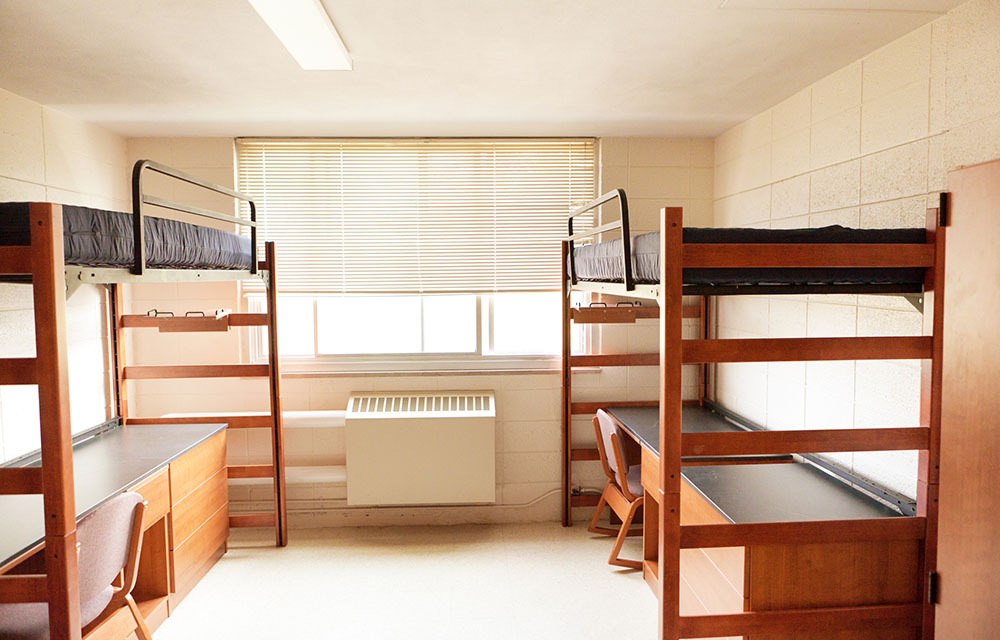Wraparound services like transportation assistance and child care foster student success. This post highlights how some community colleges are supporting student parents.
Affordable College, Unaffordable Living: How Community Colleges Develop Student Housing
Recently, we wrote about how community colleges were leveraging preexisting partnerships and programs to provide housing solutions in the short term. In addition to quicker fixes, colleges are also confronting bigger, longer-term problems in a variety of innovative ways that seek to get at the root of the housing problem.
Meeting Students Wherever (and Whoever) They Are
A notable hurdle for community college housing is the wide range of students that attend these institutions. In addition to more traditional student personas, community colleges also serve many adult learners and students with dependent children, which can make the four-year university dorm model a less than ideal fit. As community colleges expand their programming to fit the needs of their communities, as well as to attract new students, different student populations emerge with unique, and occasionally conflicting, housing needs.
Traditional Postsecondary Students
Traditional-age college students, who enter college the fall after completing high school, are more likely to choose to enroll at a four-year institution than a community college. More specifically, twice as many attend four-year colleges and universities than community colleges. One reason for this differentiation may be the more communal campus experience found at most four-year institutions, where the majority of first-year students live in on-campus dorms. This environment is less common at community colleges, which could be less attractive for younger students who are eager to move away from home.
Student Athletes
Some community colleges use athletics to grow and/or maintain their student populations. Student athletes tend to be from areas that are farther removed from campus than nonathletes. Additionally, many are international students who will require a place to live as they study in the United States. According to the IPEDS Institutional Characteristics Survey, 45 of the 122 community colleges in the Fifth District are members of national athletic associations, making this a student population of interest in our region. Recent pressures to NCAA transfer policies may increase collegiate sports on community college campuses, and we have heard from our outreach that many campuses are contemplating adding or expanding athletics, thus increasing the need to house additional students.
Adult Learners
Creating living spaces for adult learners alongside their younger peers can present challenges to the traditional dorm model both in design and facility requirements. Rather than using communal bathrooms and an external dining hall, these students would likely be better served by a more conventional apartment model with private bathrooms and in-unit kitchens. Adult learners are also more likely to have a partner who would be living with them, potentially necessitating allowing nonstudents to reside in campus housing.
Student Parents
And, of course, many of these adult students are also parents. Of the 3.14 million undergraduate students who are parents, 51 percent attend community and technical colleges. Being a student parent can create unique obstacles for student housing. A traditional dorm model is not designed to be child-friendly, so additional considerations may need to be made to best house this student population and their dependents alongside their student peers.
Building Room to Grow
Community colleges are tasked with finding long-term housing solutions that address the needs of the various student populations that they serve. Approximately 25 percent of community colleges have pursued a more direct answer to addressing their students' housing needs by developing housing themselves or through public-private partnerships. Based on the Richmond Fed's analysis of public two-year institutions using IPEDS data, 27.5 percent of these schools nationwide had institutionally controlled housing (on- or off-campus) while only 2.5 percent (three of the 122 community colleges) in the Fifth District had student housing as of 2023. Among the community colleges that have developed their own housing, different strategies have emerged to provide the financing, land, and management necessary to create these new facilities.
On-Site Student Housing
For students who want to participate in communal campus life and limit commuting costs, on-campus housing can be a solution. Students able to live on-site at their community college are in closer proximity to the other wrapround services provided by the school, which allows for a more holistic system of support.
Community colleges frequently have underutilized land, including parking lots or vacant buildings, that can ease the financial strain of land acquisition for future on-campus student housing projects. Some even have very large campuses that include open spaces that would, at least in theory, be perfect locations for dorms or apartments. In some cases, community colleges are choosing to build college-owned and operated dorms, similar to what you would see on a four-year college campus.
However, even when land is plentiful, community colleges may not want to own or operate the housing units themselves. In these cases, long-term ground leases can help colleges maintain ownership of their land and ease financial strain by leasing land to private developers for a set period of time (often between 30 and 99 years). The developer can construct housing on that land and take on the costs of development themselves, while paying the college for the right to use the land. This option also utilizes private student housing companies for the ownership and/or management of the student housing units until the term of the lease is up. These public-private partnerships reduce risk for both the college and the student housing company, which would typically be guaranteed renters via master leases.
Operating on-campus housing can be an expensive and risky proposition even after construction, partially due to liability insurance costs. Additionally, most community colleges are not accustomed to being inhabited around the clock, and the services needed to accommodate this can be expensive. This can require additional staffing and physical space for services such as on-site dining and security, which adds an additional financial burden to an already expensive undertaking.
Off-Site Student Housing
For some community colleges, college-owned land may be limited or inaccessible for development, making off-site student housing more feasible. Building housing away from the main campus can extend the benefits beyond the confines of campus by providing additional housing stock to the area, as well as by attracting a broader demographic of students.
While off-site housing introduces more flexibility in location, it may also present a higher upfront development cost. Funding is a major barrier to community colleges providing their students with different wraparound services, and housing is no exception. With limited public resources available to finance student housing, many institutions must rely on private capital, which can require the funders to come up with innovative strategies to secure the necessary funding themselves.
Southwest Virginia Community College was able to begin developing off-campus housing for their students through their Educational Foundation. The foundation owns the land and will manage the property after building is completed. This model allows for more flexibility in the use of any potential revenue from a student housing project since foundations are not limited by public funding restrictions. It also helps prevent the cost of construction from being passed on to students in their tuition since the finances of the housing development are held apart from the school itself.
North Carolina has a framework for partnership between community colleges and the counties in their service area to collaborate on development projects. While colleges in North Carolina are empowered to purchase land within their county of service given local and state approval, in instances where the college may not want to take on construction debt themselves, the county can act as a partner. Community colleges can avoid taking on additional debt by selling or leasing land to the county, and the county can leverage their own financing options for developments or improvements to the land. After the county's financing is paid off, then the land ownership would revert back to the community college.
Though developing off-site housing can increase flexibility and scale, zoning issues may arise if the locality has stricter policies for multifamily housing and design restrictions like building height or required parking. Some projects, particularly those near more suburban campuses, may also encounter community pushbacks from neighbors who do not want the single-family feel of their neighborhood to change (a position often described as NIMBYism -- Not in My Backyard).
Policy Challenges
Even if community colleges can accomplish the undertaking of acquiring land resources and funding, unique policy constraints can stand in the way of building student housing.
Campus Land Ownership
In multiple Fifth District states, community colleges do not have land ownership rights over the campus, preventing them from building on-campus housing. In Virginia, the State Board for Community Colleges hold ownership rights to campus property, while in Maryland the local county government holds the legal title. Community colleges in these states do not have the authority to build on-campus housing or enter into ground lease agreements without express approval from the property owner, which can be difficult to secure due to differences in priorities.
Bond Restrictions
Some states limit community colleges' ability to raise money through revenue bonds for housing, as four-year institutions would normally do. Often, community colleges are required to get external approval before accessing revenue bonds. For example, South Carolina's community colleges can issue revenue bonds for financing capital projects with the State Fiscal Accountability Authority's approval. Similarly, in Maryland, community colleges have the authority to issue bonds for capital projects but only through an agreement with the Maryland Health and Higher Educational Facilities Authority and the county governing body.
We Want to Hear from Community Colleges
Unlike shorter-term solutions that focus on getting students into housing as soon as possible by leveraging existing relationships or programs, longer-term solutions take more resources because they seek to more permanently address the housing needs of students. In our outreach, we have encountered institutions that are working to solve these issues in unique ways, always with an eye toward making housing affordable for the students they serve.
In that vein, we want to hear more of not only the innovative ways colleges are addressing housing difficulties, but also about other wraparound services like childcare, health care, etc. This year's Richmond Fed Wraparound Services Survey has officially launched, and we hope to hear from colleges across the United States.
Views expressed are those of the author(s) and do not necessarily reflect those of the Federal Reserve Bank of Richmond or the Federal Reserve System.
Receive an email notification when a new Community College Insights article posts:
Related Content
Although community college enrollment has increased, housing has also become a growing obstacle for student success.



